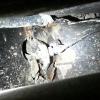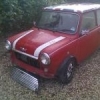Alloy Suspension Parts
#31

Posted 31 January 2013 - 05:49 PM
#32

Posted 01 February 2013 - 02:30 AM
Fatigue ? to avoid fatigue keep any cycling forces within the elastic region of the material/s used.
***
Just to clarify Aluminium parts are fatigue rated by the number of cycles, ferrous and titanium does have fatigue points that must not be exceeded, unless you want it to break.
***
Edited by mra-minis.co.uk, 01 February 2013 - 10:59 AM.
Tiger99 pointed out an error
#33

Posted 01 February 2013 - 10:36 AM
In mild steel, to stay below the fatigue threshold you need to keep the strain below about 45% of the elastic limit, but alloy has no fatigue threshold, and all that happens as you lower the peak to peak applied strain is that the number of load cycles before failure increases. It does not increase to infinity, as with steel, and all alloy structures will eventually fail if fluctuating loads are applied. All that can be done is to be very sure of the actual loads, and design for either a safe life, after which the part must be replaced, or design for a life which will always exceed the life of the car.
It follows that, for example, using second hand alloy wheels which have already lasted the life of one car is dangerous, as they have probably already had their designed number of load cycles, and may be very near to fracture.
The car industry is, as those with inappropriate alloy parts are now getting older, about to experience the problems which beset the aircraft industry in the 1950s and 1960s.
#34

Posted 01 February 2013 - 10:55 AM
If that where the case then why arn't alluminium wheels falling apart ? some new alluminium wheels are failing simply because the material, product design and manufacturing processes are incorrect, I suspect along with very little testing to back up the deign.
Having been involved with quite a few alluminium parts manufactured for the automotive and aerospace industry, I would agree that there may be an issue with material choices for certain products, however here's where design gets it sorted....
For instance the Jaguar top and bottom arms made from alluminium both have bearings in the ends that will NOT last as long as the arm, the sealing boots will fail and allow grit etc to enter the bearing causing it to fail, the whole arm then needs to be replaced, this is not a strength issue but a reliability in service safety issue, the OP will hopefully pick a grade of alluminium that caters for the safety requirements before he makes the parts.
#35

Posted 01 February 2013 - 12:54 PM
The very real danger here is that someone will provide a reconditioning service for those arms which involves fitting new bearings to already fatigued arms. There is always someone unscrupulous enough to do it, but it is more likely to be done in sheer ignorance, just like the alloy wheel "reconditioners".
#36

Posted 01 February 2013 - 04:07 PM
What has been identified in this thread is the potential for big safety issues if these current cars using aluminium suspension components become true 'classics' in about 40 to 50 years time and the aluminium parts start failing after being 'restored', no brand new parts being available. Still, that won't be our problem
#37

Posted 01 February 2013 - 04:59 PM
What would be very interesting to know would be the loads and working life assumed by the manufacturers, becuase it is always possible that a high mileage driver, or someone who drives all the time on rough roads, would exceed it. Unfortunately, we are unlikely to ever get that information, which is rather worrying, as a certain well-known manufacturer, known for being rather economical with assumed stress levels, is already turning out cars with things that break, rear suspension being one, at relatively modest mileage. I don't know if they are using alloy or not.
I note that the one remaining Vulcan bomber is probably going to be retired this year, as otherwise it will need major work to counteract fatigue. I must admit that I am hoping that they will find the money to do the work, which is major. The airframe apparently is equipped with fatigue meters, so they can tell when it has reached its rated number of load cycles. A more modern version of the fatigue meter may have to come to cars, if alloy becomes more pervasive.
#38

Posted 01 February 2013 - 06:02 PM
Still, that won't be our problem
.
Speak for yourself coolerman
We already have these problems with minis, ball joints, refubed parts etc
#39

Posted 01 February 2013 - 06:09 PM
On a classic car like a Mini it would seem very unwise to fit after-market aluminium alloy components to suspension, braking or steering as the companies making those bits just don't have the data needed nor the means of using that data even if they did have it.
Who can remember the de Havilland Comet 1? (I can as I worked for the company a few years after the problems).
#40

Posted 01 February 2013 - 09:23 PM
What has happened is that the conflicting requirements of low fuel consumption and crash-worth design has created the need for lighter-weight structure and as carbon-fibre/composite construction is not financially viable for mass-produced cars the designers have turned to al. alloy. This, then, gets them over the current issue and down-line, say after 10+ years they probably don't care. For any highly stressed components or, more critically, those likely to take shock loading, the need for adequate fatigue analysis and safe-life definition is necessary, but won't happen one might suppose.
On a classic car like a Mini it would seem very unwise to fit after-market aluminium alloy components to suspension, braking or steering as the companies making those bits just don't have the data needed nor the means of using that data even if they did have it.
Who can remember the de Havilland Comet 1? (I can as I worked for the company a few years after the problems).
A good example of what happens when you don't really fully understand metal fatigue, I suppose loosing the wings is the aircraft equivalent of loosing a wheel, only rather more problematic when you're a few thousand feet up!
#41

Posted 01 February 2013 - 10:53 PM
#42

Posted 02 February 2013 - 12:30 AM
The end-of-life vehicles regulations and things like the replacement schedule of the many, many airbags now being fitted effectively limit the lifespan of any current vehicle to 10 years. it is highly unlikely there will be a classic car market based around any current vehicles in 15 years time.
Think you're right there. Maybe one or two, like the Subaru Impreza, Aston-Martins, Porsches, etc, but not normal saloons. They have no character anyway and would be hard for a DIY enthusiast to keep in use with the electronics being hard to maintain.
Still, our classics like the Mini, MGB, and other 60's cars will still be around one might hope. Really we enthusiasts are responsible for preserving the Mini for future generations to continue to enjoy as we enjoy them.
#43

Posted 02 February 2013 - 01:05 AM
So Jaguar have effectively set a life on the arms by ensuring that they need replacement due to failed bearings well within the fatigue life. That is one way of achieving the required objective.
The very real danger here is that someone will provide a reconditioning service for those arms which involves fitting new bearings to already fatigued arms. There is always someone unscrupulous enough to do it, but it is more likely to be done in sheer ignorance, just like the alloy wheel "reconditioners".
I agree, and if a crash did occur due to a failure, it would be similar to the mini ball joint failure.... "it must have happened because the driver was going to fast" instead of the part failed which caused the accident :-(
#44

Posted 02 February 2013 - 01:08 AM
Yes, that will indeed be a problem, but I think in less than 40 years. I don't think the average manufacturer supports their products for much more than 10 years, and few have the decency to set up an operation like Heritage.
What would be very interesting to know would be the loads and working life assumed by the manufacturers, becuase it is always possible that a high mileage driver, or someone who drives all the time on rough roads, would exceed it. Unfortunately, we are unlikely to ever get that information, which is rather worrying, as a certain well-known manufacturer, known for being rather economical with assumed stress levels, is already turning out cars with things that break, rear suspension being one, at relatively modest mileage. I don't know if they are using alloy or not.
I note that the one remaining Vulcan bomber is probably going to be retired this year, as otherwise it will need major work to counteract fatigue. I must admit that I am hoping that they will find the money to do the work, which is major. The airframe apparently is equipped with fatigue meters, so they can tell when it has reached its rated number of load cycles. A more modern version of the fatigue meter may have to come to cars, if alloy becomes more pervasive.
The car industry refer to this as the 90 percentile testing parameters.
A stress gauge and a volt meter feeding directly to a lap top will give you a fair amount of data....
#45

Posted 02 February 2013 - 01:12 AM
What has happened is that the conflicting requirements of low fuel consumption and crash-worth design has created the need for lighter-weight structure and as carbon-fibre/composite construction is not financially viable for mass-produced cars the designers have turned to al. alloy. This, then, gets them over the current issue and down-line, say after 10+ years they probably don't care. For any highly stressed components or, more critically, those likely to take shock loading, the need for adequate fatigue analysis and safe-life definition is necessary, but won't happen one might suppose.
On a classic car like a Mini it would seem very unwise to fit after-market aluminium alloy components to suspension, braking or steering as the companies making those bits just don't have the data needed nor the means of using that data even if they did have it.
Who can remember the de Havilland Comet 1? (I can as I worked for the company a few years after the problems).
A good example of what happens when you don't really fully understand metal fatigue, I suppose loosing the wings is the aircraft equivalent of loosing a wheel, only rather more problematic when you're a few thousand feet up!
I wouldn't know !!! I never drive my car this high
1 user(s) are reading this topic
0 members, 1 guests, 0 anonymous users



















